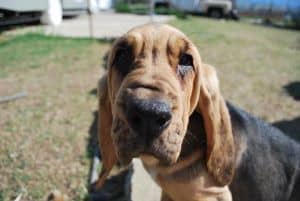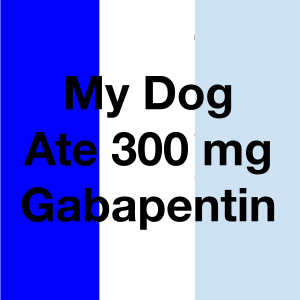Did you notice that the small bump towards the rear of your dog’s head seems to be getting bigger?
The “smart bump” (officially called an occiput) is a normal part of a dog’s anatomy and seems to be more pronounced in some dog breeds, especially Labradors.
However, a change in size or appearance can be a cause for concern.
A dog’s occiput is supposed to remain fairly the same size and look just about the same for most of their lives, although it can temporarily appear bigger as the dog grows from a puppy to an adult.
While a dog’s occiput getting bigger can signify a growing dog, it can also be a sign of a much bigger problem.
What you will learn from this article:
- What is an occiput?
- Why do dogs have occiputs?
- Do occiputs grow?
- Can occiputs become swollen?
- What dog breeds tend to have more prominent occiputs?
- What are the most common shapes of dog heads?
- Can head shape predict how a dog behaves?
- Can dogs get concussion?
- Closing Thoughts
What is an occiput?
The word occiput literally means the back part of the skull or head, and it’s present in most mammals, including humans and our favourite companions, dogs.
The occiput (also known as the occipital bone) is a perfectly normal part of a dog’s anatomy, and it’s the only part of the skull that connects to the neck and provides a passage for the spinal cord.
And although it’s present in every dog, not all dog breeds have a prominent occiput.
For dogs with a prominent occipital bone, it appears as a slight bump on the back of their head and was thought to be a mark of intelligence, hence it’s sometimes referred to as the “knowledge bump,” “wisdom bump,” smart bump,” “intelligence bump,” etc.
Why do dogs have occiputs?
In the wild, dogs were originally exposed to predators that would attack by delivering a crushing bite to the skull.
The occiput was the major form of protection for the skull, and it acts as a powerful barrier that provides a stronger resistance to the jaws of predators, making it harder for them to crush the skull and damage the brain.
While the main function of the occiput is to provide a solid cushion for the brain, it does have other functions.
The crest of this bone is covered with several nerve endings and muscles that attach the head to the neck, which is responsible for the flexibility of the neck and the variety of head movements you observe in your dog.
Do occiputs grow?
A dog’s occiput will only grow at the same rate as the skull, and its size will be proportionate to the size of a dog’s skull and head.
This is to say that, if your dog had a prominent occiput as a puppy, it should remain fairly the same size at adulthood.
And a puppy with a fairly visible occipital bone, will also have a fairly visible occiput as an adult dog.
Generally, it takes between 6 and 24 months for dogs to finish growing.
Usually 6 to 8 months for small dog breeds, about 12 months for medium dog breeds and up to 18 to 24 months for large/giant dog breeds.
And during their growth stages, dogs experience skeletal growth, which involves the growth and development of their bones, including their skulls and of course the occiput.
However, when a dog has finished growing, the bump on the head wouldn’t continue growing on its own.
If you notice that your dog’s occiput appears to be more prominent than it used to, then this is most certainly an indication of a problem.
An occipital bone that suddenly becomes larger than normal needs to be quickly examined by a vet.
Can occiputs become swollen?
The occiput can become swollen or appear to be growing bigger.
An occiput that appears to be growing bigger may be a sign of a growing dog, but if it obviously appears bigger than usual or looks swollen, then it should be quickly examined by a vet as this may be a sign of Myositis.
Myositis is a medical term used to refer to any condition that relates to muscle disease, usually an inflammation of a muscle or group of muscles, and symptoms include weakness, swelling and pain.
Since the occiput is a skull bone that is covered with a variety of muscles, it can be affected by Myositis, which can cause swelling and pain.
Masticatory Muscle Myositis (MMM), an inflammatory disease that affects the muscles of the face and head used in chewing food, can also cause the occiput to swell.
In some dogs, one of the first signs of MMM can be a swelling of the muscles at the top of the head.
And as the condition worsens, the facial muscles (including the jaws and eyes) also become swollen, causing tremendous pain for the dog.
Dogs with MMM find it very difficult to open their mouth or move their head, and eating becomes a very painful ordeal.
Multilobular bone tumour or muscle atrophy can also cause a big bump on a dog’s head. If the smart bump on your dog’s head is swollen, or the top of the head is getting bigger, then a visit to the vet is in order.
What dog breeds tend to have more prominent occiputs?
The occipital bone is present in every dog breed, however, some breeds are known to have more prominent occiputs.
A very pronounced head bump is mostly seen in sporting dog breeds, especially the Bloodhound, Labrador, Golden Retriever, Basset Hound, and English Setter.
What are the most common shapes of dog heads?
While most wild dogs look very similar with almost identical head shapes, domestic dogs have very different head shapes, which is a direct result of centuries of continuous breeding and crossbreeding.
The varied shapes of dog skulls and heads are generally placed in three different groups; dolichocephalic, mesaticephalic, brachiocephalic.
- Dolichocephalic breeds are dogs with pointy heads and long muzzles; examples of these breeds include the Greyhound, Whippet and Saluki.
- Mesaticephalic breeds are dogs with medium-shaped heads, their muzzles are neither too long nor too short. Examples of these dogs include Golden Retrievers, Labradors, German Shepherds, and Beagles. These dogs tend to have the least problem with head and neck related issues, and most wild dogs fall into this category.
- Brachycephalic breeds are the exact opposite of the dolichocephalic dogs. These dogs have very short faces/noses with very and almost non-existent muzzles. Examples of brachycephalic dogs include Pugs, Bulldogs, Pekingese.
These three categories only broadly group the basic dog skull types and head shapes. Beside these groups, there are many other subgroups for classifying dog head shapes based mostly on physical appearance.
Some of the most common dog head shapes include;
Wedge shape: this head shape has a long, blunt wedge that slightly tapers from ears to nose. Most dog breeds with wedge-shaped heads fall under the mesaticephalic category and examples include Sheltie, Tenterfield terrier, Golden retriever, German shepherd, etc.
Blocky or square-shaped head: this head shape is usually squarish or cube-shaped with a blunt, upturned nose. Most dog breeds with square-shaped heads are brachycephalic and examples include Boxer, Boston terrier, Bullmastiff, Bulldog, etc.
Snippy (or pointy) head: this head shape is long and narrow, with a very pointy and long nose. Dogs with snippy or pointy heads are dolichocephalic, and examples include Greyhound, Borzoi, Whippet, Afghan hound, Collie, Saluki, etc.
Apple head: the apple head shape is used to describe dogs that have a skull with a rounded or dome-shaped top and a small snout. A very popular example is the apple-head Chihuahua. Another example is the Poodle.
Egg-shaped head: The Bull terrier is the most common dog with a head that’s shaped like an egg. It has an oval appearance, just like an egg or a rugby ball.
Dome-shaped head: this describes a dog head with a rounded top and slightly convex nose, this head shape is seen in Cocker Spaniels and Rottweilers.
Pear-shaped head: this head shape is mostly used to describe the lamb-like Bedlington terrier, with a rounded skull with a narrow or tapering nose.
Brick-shaped head: this describes a long and slightly dome head that is rectangular and shaped like a brick. Example dog breeds include Scottish terrier, Kerry Blue Terrier, Black Russian Terrier and Soft Coated Wheaten Terrier.
Otter head: the Border terrier has a broad skull with a short muzzle that is said to resemble an otter’s head.
Can head shape predict how a dog behaves?
It’s not usual to wonder about the personality and characteristics of an adorable dog you came across at your city park.
And this can be a challenge if it’s an unfamiliar dog breed.
However, a recent research study suggests that you can tell the behaviour, temperament and personality of dogs from their physical appearance, such as head shape and body size.
According to this study, brachycephalic dogs tend to have a higher interest in humans and enjoy plays and activities which allows them to be fully engaged with their human family, they are mostly lap dogs.
Flat-faced dogs also tend to be more defensive when faced with a difficult situation. Dolichocephalic dogs tend to be more aloof and independent, and they care less about human engagement.
And mesaticephalic dogs tend to be very intelligent and highly trainable.
The study also suggests that a dog’s size can give information on its personality. For instance, taller dogs tend to be more affectionate and playful with humans.
On the other hand, shorter and smaller dogs generally tend to be more aggressive, especially towards strangers and unfamiliar objects.
Shorter and smaller dogs also demand more attention from their owners, while taller dogs tend to be more reserved.
Can dogs get concussion?
Although dogs have thick skulls, they can still have head injuries. And a serious trauma to a dog’s head can cause a concussion.
Dogs can get concussion from a bad fall or an accident, and some common symptoms of dog concussion are lethargy, disorientation, inability to stand, walk or move, rapid eye movement, etc.
A dog can also lose consciousness when involved in a bad accident, and a very severe head injury can lead to brain damage.
If you notice that your dog is exhibiting one or more of the above symptoms after a bad fall or car accident, please visit the vet as soon as possible.
Treatment for concussion depends on the severity of the case, a minor concussion may only require rest and observation, but a severe concussion needs special care and examination for possible brain damage.
Closing Thoughts
As a part of the skull bone, the occipital bone has the very important function of protecting both the dog’s skull and brain.
A prominent occipital bone was once thought to be a mark of a dog’s intelligence, and dogs with a pronounced occipital bone were thought to be very smart and highly trainable.
Whether a dog has a prominent occiput or not, it’s very unusual for it to suddenly start to get bigger or look swollen. A swollen occipital bone can be a sign of an inflammatory muscle disease and should be examined by a vet as quickly as possible.






